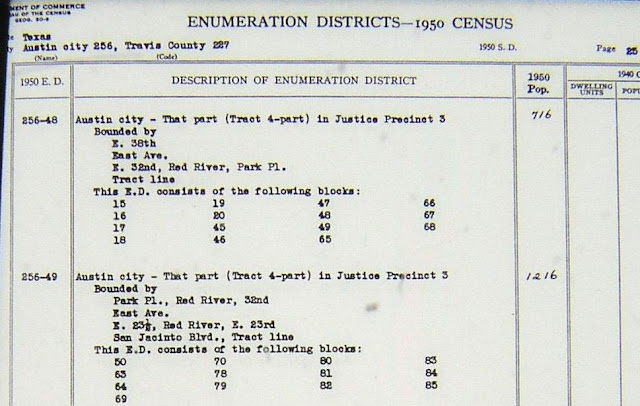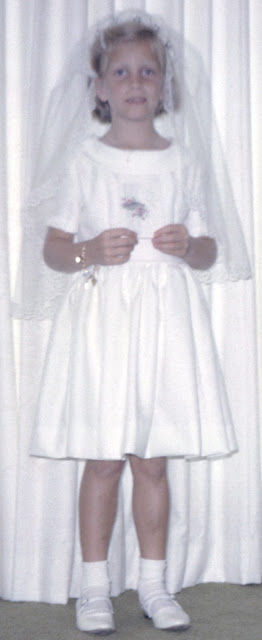I've been preparing for the upcoming release of the 1950 United States Census on April 5, 2022, by trying to figure out where various family members were in April 1950. The Census is supposed to have a rudimentary index when it is released (thanks to machine learning to recognize handwriting), but I want to be prepared to browse by enumeration district if necessary. And therefore, I need to know where family members were in April 1950, so I can find the correct enumeration district (ED) in advance.
In many cases, I already have addresses, thanks to my late mother and thanks to so many city directories being available online. One challenge I ran into, however, was trying to locate my maternal uncle, my mother's older brother Charles Thomas Guokas III (1927-1999).
Charles Guokas III as a junior at the University of Texas at Austin. From the 1949 Cactus yearbook, page 92, image 96.
Uncle Charles, who served in the Navy during World War II, appears in the 1949 yearbook for the University of Texas at Austin. He is also listed in the Austin City Directory for that year (page 300). The latter says he is a student at U of T residing in FPHA Dorm H.
So just where was FPHA Dorm H? It's not on the UT-Austin campus today.
I made a comment on a post about another dorm in The UT History Corner blog, and received a private reply from blog author Jim Nicar. He said,
Thousands of veterans, returning home after the war, decided to go to college under the G.I. Bill. For UT, enrollment more than doubled in the short three months between June and September 1946, which required some quick action on hiring more instructors, finding classroom space, and getting additional housing. ...Part of the housing issue was solved through the FPHA - the Federal Public Housing Authority - which provided used, wartime "hutments" and transported Bachelor Officer Quarters, or "BOQs", from military bases to college campuses as temporary dorms. The University installed a row of BOQs along today's San Jacinto Boulevard, most of them at the north end, and gave them letter names.Attached is a 1950 map of campus, with the "H Dorm" circled in the upper right. Today, it's the site of the San Jacinto Parking Garage.
A portion of that map, from the Office of the Supervising Architect and dated 16 March 1950, is below (click on the image for a larger view). I've also annotated it to show the enumeration district it fell in - more on how I found that next.
When I was prepping for the release of the 1940 Census ten years ago, I used a number of great census tools on Stephen P. Morse's website. The Unified 1880-1950 Census ED Finder includes a tool to find and view ED maps for a city or county from the National Archives and Records Administration (NARA). For example, here is a portion of the 1950 ED map for Austin (click on the image to make it larger):
This map has tape running right through the area where the FPHA Dorm H was located, so I felt I needed a little additional information to locate its ED. When you use the Unified 1950 Census ED Finder. you can choose to view a description of the ED's boundaries from NARA microfilm. Here is the description for ED 256-49 (the 256 indicates that it is Austin) - click on the image to make it larger.
After seeing what the boundaries were, and drawing them on the 1950 map of the University of Texas campus, I feel confident that FPHA Dorm H is in ED 256-49. When the 1950 Census is released on April 1, I can use the link on the Universal 1950 Census Image Viewer page to maneuver directly to Texas ED 256-49, and browse through all the images of census pages in that ED until I find Uncle Charles.
That is, assuming he still lived in FPHA Dorm H in April 1950.
Uncle Charles does not appear in the 1950 UT-Austin yearbook. Furthermore, he ultimately graduated from what was was then North Texas State College (NTSC, now the University of North Texas or UNT) in Denton on June 3, 1951, with a Bachelor of Business Administration degree in Management. However, he does not appear in the 1950 nor the 1951 NTSC yearbooks.
I used the same process I described above to get a map of the 1950 EDs for the city of Denton, where NTSC (now UNT) is located. You can see a block marked N.T.S.C. in the image below (click on it to make it larger). However, I had a feeling the same situation was occurring at NTSC as at UT-Austin, with the college rapidly expanding. Furthermore, I attended UNT in person in the spring of 2006 (to finish my masters in library science), and I knew some of the older buildings on campus extended beyond the area marked as the college on this map.
Most of the residence Halls that were running between 1949 and 1951 were first opened for women and then were changed over to hold men as more dorms were built. Below is a list of dorms or other structures used to house students during these years:Marquis Hall - Chilton Hall - Terrill Hall - Music Hall - Orchestra Hall - Oak Street Hall - Vet Village (married couples) - Bruce Hall - Legett Halls (a collection of rooming houses)
I also looked at the 1949-1950 catalog online, and found that Marquis, Terrill, Oak Street, and Bruce Halls were for women (page 64). Chilton and Legett were men's dorms, along with Ramey Courts, as well as the Little Dormitories, which do not appear on the 1949 map but are, like Legett Halls, "four blocks from the library" (page 66). The catalog does not mention Music or Orchestra Halls being used as dormitories.
Below, I annotated the map she sent to include the relevant EDs from the NARA map above. I marked the relevant dorms with red dots. Since I don't know which dorm Uncle Charles lived in, I will start my search with ED 61-13 (since it contains two of the most relevant dorms, Chilton and Ramey Courts), followed by ED 61-14 (Legett Halls and possibly Little Dormitories) and then ED 61-12 (Music and Orchestra Halls). Click on the image to make it larger.
© Amanda Pape - 2022 - e-mail me!








